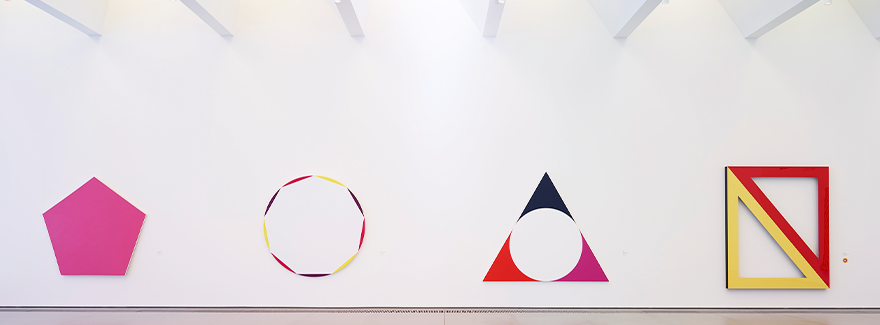A Matter of Pure Form. Constructivist-concrete Art from the Weishaupt Collection

Triangle, rectangle, circle or line: our current exhibition brings together works of art that are based on geometrical shapes and that thus at first sight seem to be only matters of pure form. But this exhibition from the collection of Siegfried and Jutta Weishaupt shows that these works are not at all based only on formal routines, and that approaches to basic mathematical forms using various techniques and artistic concepts can be very diverse.
A work by Piet Mondrian from the 1920s stands for a radical abstract and geometrical pictorial idiom, with a strictly right-angled set of black lines combined with white surfaces and colour fields in the primary colours red, blue, and yellow. Mondrian’s striking grid-based pictures made him world famous, and they are very common to this day in architecture, fashion and design.
Precise shapes and mathematical systems are also the central design principle of the Zurich school of concrete artists, represented here by works by Max Bill, Camille Graeser, Verena Loewensberg, and Richard Paul Lohse. The founders of this art movement did not intend their works to refer to a reality outside of the space of the image. Working very precisely and seeking out a harmonious balance, they created powerful compositions, whose surfaces, colours and forms were the only object of this art.
Josef Albers’s works are based on scientific principles, and they challenge our experience of seeing. His main concern was to explore the relations of colours to each other, and the mutability of their effects in different constellations. To demonstrate this, he also drew on a geometrical shape – the square. Complementing the work of Josef Albers are pieces by various artists, so that reflection on a pictorial structure based on the square opens up a many-faceted panorama.
Further versions of the main theme are in impressive large formats. In the work of Bridget Riley, for example, geometrical patterns come together as irregular diagonal colour strips. As a proponent of op art, she plays with our perception. A focus on what is depicted seems to be impossible, and the eye starts to wander around the canvas, following a rhythm that is immanent to the image. Both in painting and in sculpture, contemporary positions by Philippe Decrauzat, Stéphane Dafflon, Imi Knoebel, and Gerwald Rockenschaub continue the broad range of artistic approaches that use clear forms and opulent colours.
The picture on the exhibition poster, Günter Fruhtrunk’s 1972 work Große Kadenz, shows how powerful the seemingly simplest geometrical form of the straight line can be. Although this work is now fifty years old, it still enthrals us with its energetic and incredibly modern symbiosis of stringent form and a striving for freedom. By very slightly offsetting his accurate colour stripes from their diagonal alignment, and also by means of a hardly noticeable break in the symmetrical sequence of colours, Fruhtrunk creates the effect that his long lines and stripes seem to be pushing out of the frame and wanting to extend into the surrounding space. “A matter of pure form“ here becomes a boundless visual treat!
Artists in the exhibition
Josef Albers, Max Bill, Antonio Calderara, Stéphane Dafflon, Philippe Decrauzat, Günter Fruhtrunk, Karl Gerstner, Camille Graeser, Peter Halley, Auguste Herbin, Imi Knoebel, Verena Loewensberg, Richard Paul Lohse, Gerold Miller, Piet Mondrian, François Morellet, Bridget Riley, Gerwald Rockenschaub, Frank Stella, Wolfram Ullrich, Victor Vasarely, Friedrich Vordemberge-Gildewart, Hermann Waibel, Beat Zoderer, and others.

